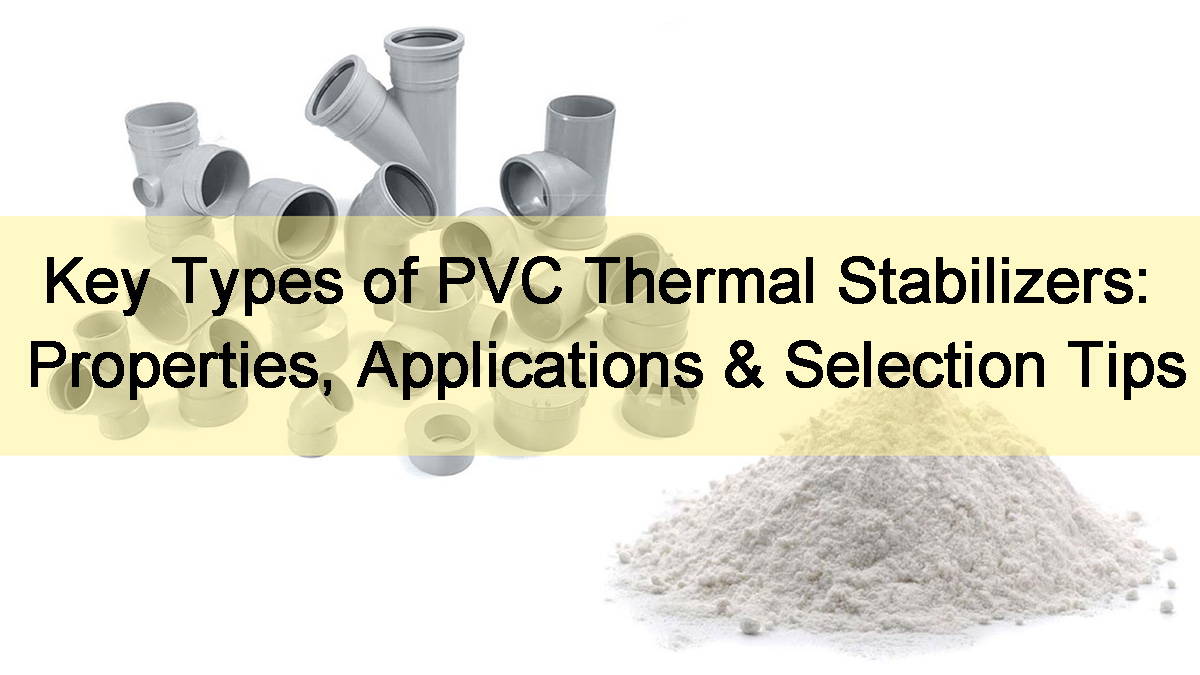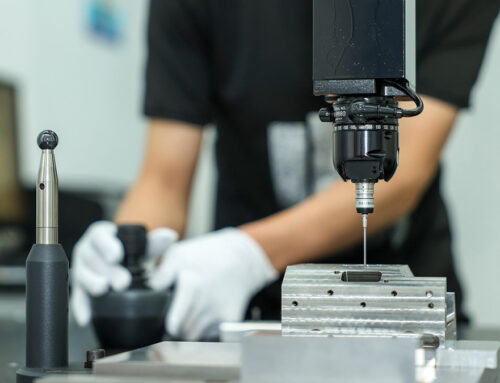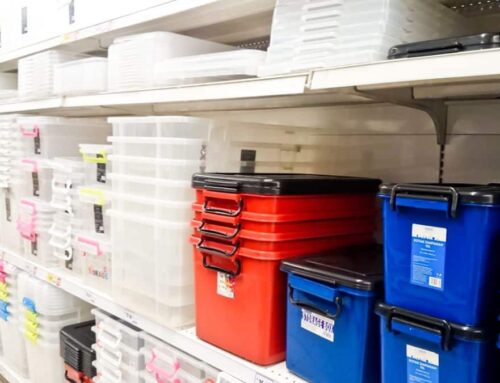PVC is a versatile polymer widely used in construction, electronics, packaging, and more, but its tendency to degrade at high temperatures makes thermal stabilizers indispensable. These additives protect PVC from discoloration, structural damage, and performance loss during processing (e.g., extrusion, molding) and long-term use. Whether you’re a PVC formulator, manufacturer, or buyer, understanding the different types of thermal stabilizers and their unique characteristics is critical for optimizing your products. This post breaks down the most common PVC thermal stabilizers, their strengths, limitations, and ideal applications to simplify your selection process.
1. Organotin Stabilizers
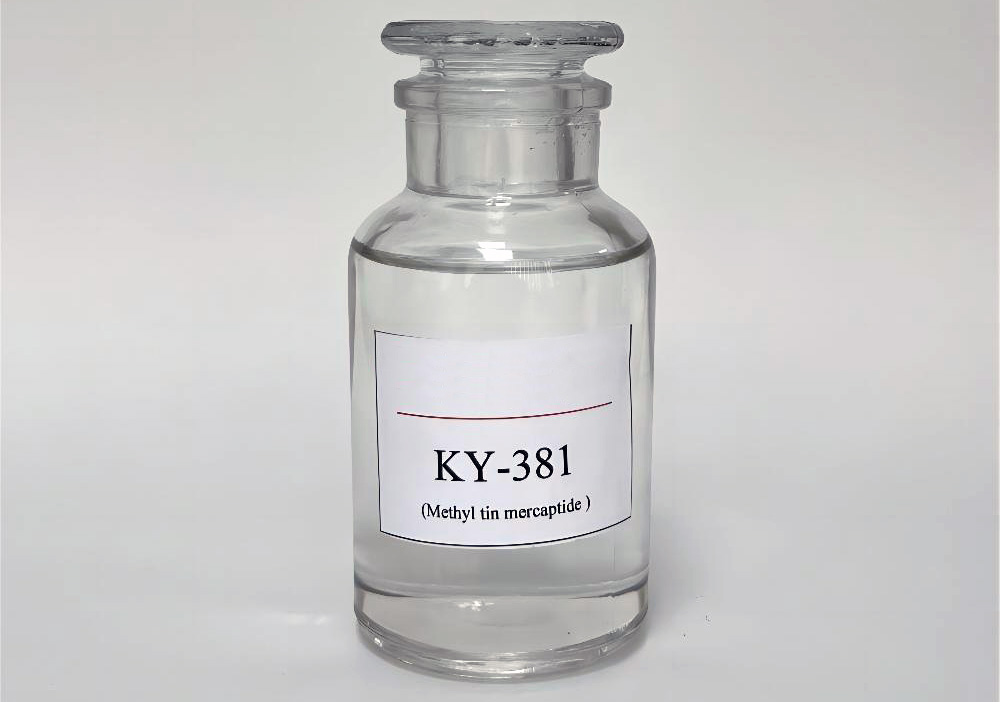
KY-381 Organotin Stabilizer
1.1 Structure and Classification of Organotin Stabilizers
Organotin stabilizers can generally be represented by the following structure: XnSnY(4-n) (n = 1 – 3)
Among which, the X group can be an alkyl group, such as methyl, butyl, octyl, or ester group. Depending on the X group, organotin stabilizers can be classified as alkyl tin and ester tin. Alkyl tin can be further divided into methyl tin, butyl tin, and octyl tin, etc. Y can be a fatty acid radical, such as maleic acid radical, lauric acid radical, or thiol radical. Depending on the Y group, organotin stabilizers can be classified as organotin maleate, organotin laurate, organotin thiolate, etc.
1.2 Properties and Applications of Organotin Stabilizers
The greatest advantage of organotin stabilizers is their excellent transparency. When using organotin stabilizers in PVC formulations, crystalline-like products can be obtained. Organotin stabilizers have extraordinary thermal stability and currently no other type of thermal stabilizer can surpass it. During extrusion, the processing temperature can reach 200 – 230 °C. Most organotin stabilizers are non-toxic, and due to the extremely low migration of organotin stabilizers in PVC, they are the most preferred thermal stabilizers for PVC processing.
Organotin stabilizers have excellent compatibility with PVC. Normally, phenomena such as “blooming” or “plate-out” like those in lead salt stabilizer and metal soap stabilizer systems won’t occur. Organotin stabilizers do not increase the viscosity of liquid PVC nor have adverse effects on the surface properties of the liquid system or the surface of the molten PVC products. Sulfur-containing organotin stabilizers have poor self-lubricating properties and to achieve good transparency of the products, the processing temperature needs to be increased. In general, though, organotin stabilizers come closer to the ideal stabilizer in terms of overall performance than any other type. That said, their primary drawback shared by all organotin stabilizers is their high cost.
2. Lead Salt Stabilizers
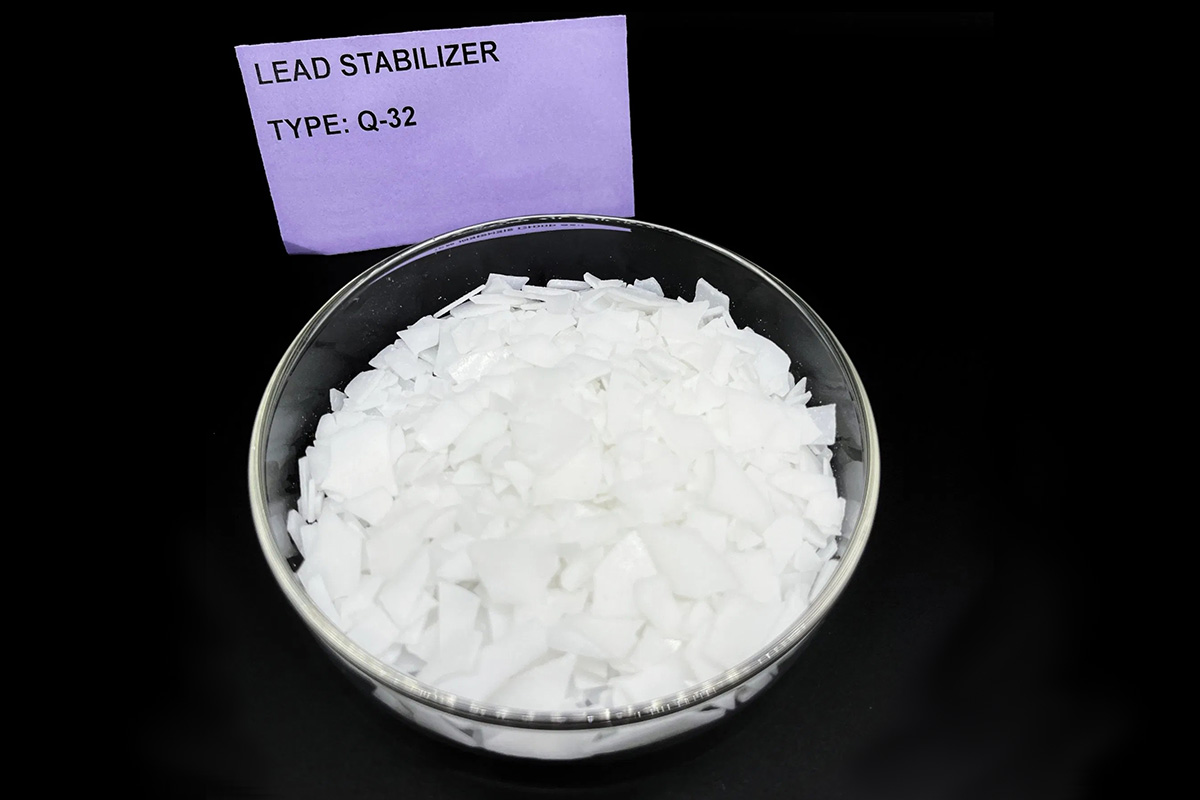
Lead Salt Heat Stabilizer for PVC Products
2.1 Overview
Lead salt stabilizers are one of the oldest stabilizers. Their ability to combine with hydrogen chloride is generally strong, and they have no inhibitory or promoting effect on PVC dehydrochlorination. The combination ability of lead oxide with hydrogen chloride is very strong, and if used as a stabilizer, it will cause discoloration of the product. Therefore, a series of white lead salts with “salt base” (PbO) have been developed. The lead salt stabilizer referred to in the industry means this type of inorganic or organic acid lead salt that combines with organic salts. The inorganic acids include sulfuric acid, phosphoric acid, and sulfurous acid, while the organic acids include phthalic acid, stearic acid, salicylic acid, and maleic acid. The greatest characteristic of lead salt stabilizers is good heat resistance and electrical insulation, low cost, and the main disadvantage is high toxicity and poor transparency. The molecular formula of tribasic lead sulfate is 3PbO·PbSO₄·H₂O.
2.2 Properties and Applications of Lead Salt Stabilizers
The advantages of lead salt stabilizers are excellent heat resistance, especially good long-term thermal stability; excellent electrical insulation; white pigment-like performance, large coverage, thus good weather resistance; ability to be used as an activator for foaming agents; and low price. Their disadvantages are relatively high density and prone to agglomeration, making it difficult to disperse evenly in the mixture; high toxicity and initial discoloration, which brings difficulties in color matching, making it difficult to obtain bright colors; lack of lubricity and transparency; prone to cause sulfur contamination. More specifically:
(1) Excellent heat resistance: Among the basic lead salts, the stabilizing ability only comes from the salt base, and the mass fraction of the salt base that can react is called the “effective lead content”. The higher the effective lead content, the better the heat resistance. The effective lead content of tribasic lead sulfate is high, so it shows better heat resistance than other products.
(2) Excellent electrical insulation: Since lead salts are non-ionized and non-conductive, they are inert. This is why lead-based stabilizers have excellent electrical insulation properties and are widely used in the wire and cable industry.
(3) Excellent weather resistance and poor transparency – these are related issues. Depending on the specific structure of the lead salt, some can act as white pigments, while those with good transparency can only achieve turbid or milky semi-transparency, all showing strong covering power, thus having strong weather resistance.
(4) Poor dispersibility and toxicity – these are 2 main disadvantages of lead salts.
(5) Notes: Most lead-based stabilizers are insoluble and cannot be extracted from PVC, so they don’t possess problems such as volatilization which other stabilizers may possess. Also, the light stability of lead salts is extremely good.
3. Metal Soap Stabilizers
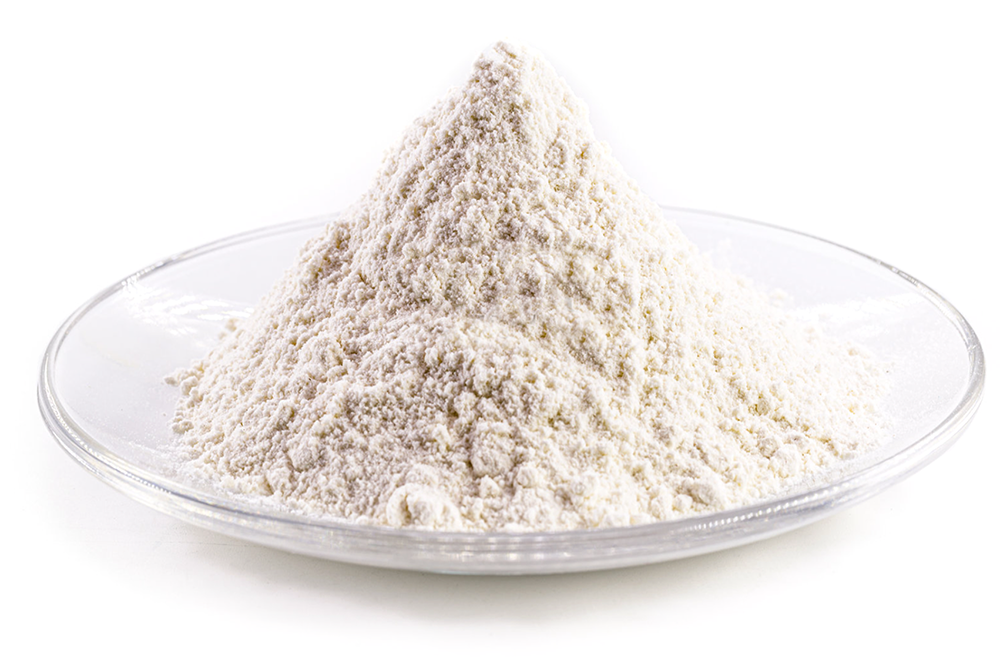
Calcium-Zinc Metal Soap Stabilizer
3.1 Overview
Metal soap stabilizers constitute a major category of stabilizers. They are collectively referred to as the salts of higher fatty acid metal salts.
3.2 Performance Characteristics and Applications of Metal soaps
(1) Cadmium Soap Stabilizer: Cadmium soap is the best performed among all metal soaps. Its advantages mainly lie in: 1. Excellent thermal stability; 2. No initial coloring, enabling the production of colorless and transparent products; 3. Excellent light stability; 4. Ability of preventing blooming and adhesion. The most widely used cadmium soap is cadmium stearate.
(2) Zinc Soap Stabilizer: Zinc soap stabilizer has extremely poor thermal stability for PVC. Samples with zinc soap added turn black rapidly when heated, resulting in “zinc burning”. Therefore, zinc soap Stabilizer cannot be used alone. Because it has the same reactivity as cadmium soap, it can be used in combination with alkaline earth metal soaps and auxiliary stabilizers to replace cadmium-based stabilizers in certain formulations. The main advantages of zinc soap are: 1. Excellent initial coloring; 2. Good anti-fouling effect; 3. Ability to improve weather resistance; 4. Non-toxicity (a characteristic of many zinc soaps), allowing them to be incorporated into non-toxic formulations alongside calcium soaps; 5. Ideal stabilization effect in paste resins. The representative product of zinc soap is zinc stearate.
(3) Barium Soap Stabilizer: The thermal stability of barium compounds is excellent, and they are widely utilized in the forms of metal soaps and liquid stabilizers. The representative product is barium stearate. These compounds produce a red initial coloring during processing, which makes it prone to causing plate-out phenomena. Therefore, barium soap is not used alone and is often combined with cadmium-zinc soap in soft product formulations. The most typical application of barium soap is in combination with cadmium soap, almost serving as a typical representative of composite metal soaps. Due to its high toxicity, barium soap may eventually fade from people’s attention. The advantages of barium soap are mainly excellent thermal stability and good lubricity.
(4) Calcium Soap Stabilizer: Calcium soap stabilizer is represented by calcium stearate. These stabilizers have poor stability but are non-toxic and have good lubricity. They have a synergistic effect with lead salts, zinc soaps, and organotin compounds, and have broad application prospects. The most typical application of calcium soap is in combination with zinc soap for non-toxic formulations, showing excellent performance in wire and cable applications.
(5) Other Metal soap Stabilizers: Aluminum stearate, magnesium stearate, calcium stearate, and zinc stearate are all non-toxic stabilizers that require the use of other stabilizers in combination.
The performance of metal soaps is significantly influenced by the type of metal they contain. Generally, cadmium soap and zinc soap have good initial heat resistance; barium soap, calcium soap, magnesium soap, and strontium soap have good long-term stability; lead soap is somewhere in the middle. Cadmium soap, zinc soap, lead soap, barium soap, and tin soap have good weather resistance; lead soap and cadmium soap have good lubricity; barium soap, calcium soap, strontium soap have poor lubricity but good gelation performance; barium soap, calcium soap, magnesium soap, and strontium soap are prone to plate-out phenomena, while zinc soap and cadmium soap are less likely to do so; lead soap and cadmium soap are highly toxic, causing sulfuric pollution, and calcium soap and zinc soap can be used in non-toxic formulations.
The hydroxy acid moiety of metal soaps also has a certain impact on their performance. Under the same conditions, generally, as the carbon chain of the acid radical increases, lubricity improves, compatibility decreases, and stratification phenomena are severe, blooming becomes more intense; however, the extraction of water by polar solvents decreases.
3.3 Composite Metal soap Stabilizers
The performance requirements for stabilizers in the processing industry are diverse, and a single metal soap often cannot meet the usage requirements. Therefore, the use of composite metal soap stabilizers has become a trend. The composite use of metal soaps is not a simple addition of performance but utilizes the synergistic effect between the components. The composition of composite metal soap stabilizers is generally not disclosed. The basic components include the main stabilizer (i.e., metal soaps), solvents (organic solvents, plasticizers, liquid non-metallic stabilizers), and functional additives (auxiliary stabilizers, transparency modifiers, light stabilizers, lubricants, etc.). According to their form, the currently used composite stabilizers mainly include solid composite and liquid composite stabilizers. Liquid composite stabilizers have the following advantages: 1. Good compatibility with PVC resin and plasticizers, rapid gelation, and excellent transparency; 2. Non-dusting property, contributing to a good operating environment; 3. Easy to achieve “one pack” formulations with phosphites and epoxides; 4. Compatible with organic solvents, good viscosity stability. While solid composite stabilizers have the following advantages: 1. Excellent lubricity; 2. Does not reduce the Vicat temperature of PVC.
(1) Barium/Cadmium Composite Stabilizer
The barium/cadmium composite stabilizer is a highly effective stabilizer. The combination of barium compounds and cadmium compounds can produce a synergistic effect. Cadmium hydroxy acid salt has excellent initial coloring properties, but poor long-term stability, while barium compounds are the opposite. The combination of the two can achieve good long-term stability. Its advantages are: 1. No initial coloring, excellent thermal stability; 2. No blooming; 3. Excellent processing properties; 4. Excellent weather resistance.
The components of the barium/cadmium composite stabilizer, apart from metal soaps, also include polyols and hindered phenolic antioxidants. In many formulations, liquid phosphites and liquid epoxy plasticizers are also included. This is because cadmium salts generate cadmium chloride during the stabilization process, which has a strong catalytic effect on the removal of HCl. The combination of phosphites, polyols, and other substances can chelate or deactivate the harmful cadmium chloride. Sometimes, to improve initial coloring and transparency, metal zinc soaps are also combined. Here is an example of a barium/cadmium/zinc composite stabilizer formula:
| Component | Content | Component | Content |
|---|---|---|---|
| Hydrolyzed diphenyl dioctyl phosphite | 8.6 | Cadmium benzoate | 8.3 |
| Pentaerythritol | 3.0 | Fatty acid zinc | 4.4 |
| Bisphenol A | 2.8 | Monophenyl dioctyl phosphite | 57.4 |
| Fatty acid barium | 15.5 | - | - |
The barium/zinc composite stabilizer was developed to replace cadmium salts. Here is an example of a barium/zinc composite stabilizer formula:
| Component | Content | Component | Content |
|---|---|---|---|
| Barium alkylphenoxide | 33.7 | Hydrolyzed triphenyl phosphite | 2.3 |
| Liquid paraffin | 19.3 | Bisphenol A | 0.8 |
| Higher fatty alcohol | 19.3 | Bisphosphite | 19.4 |
| Zinc benzoate | 4.3 | Pentaerythritol | 0.9 |
(3) Calcium/Zinc Composite Stabilizer
The calcium/zinc composite stabilizer is developed for non-toxic application fields. The following is an example of the formulation of the calcium/zinc composite stabilizer:
| Component | Content | Component | Content |
|---|---|---|---|
| Calcium stearate | 25 | Solid phosphite | 5 |
| Zinc stearate | 5 | β-diketone compound | 3 |
4. Organoantimony Stabilizers
The advantage of Organoantimony stabilizers lies in: good stability performance, low cost, and non-toxic products; its disadvantages are: poor transparency, poor light stability, poor lubricity, and cross-contamination with certain substances. Fully understanding the characteristics of the product, maximizing its advantages, overcoming its disadvantages, is very important for the rational selection of stabilizers.
5. Organic Auxiliary Stabilizers
5.1 Phosphites
Phosphites are the most widely used organic auxiliary stabilizers, an indispensable component in liquid barium/zinc and calcium/zinc stabilizers, and shows a more significant impact in the cadmium/barium/zinc system. According to their structural characteristics, Phosphites can be classified into monophosphites, diphosphites, and triphosphites. Generally, monophosphites exhibit excellent anti-blooming property and transparency, while diphosphites and triphosphites exhibit excellent weather resistance, thermal stability, and coloring performance. Adding certain phosphites to hard PVC can improve light stability. In addition, the addition of phosphites can reduce melt viscosity, making the processing of PVC easier.
In PVC formulation, the role of phosphites is first manifested in replacing allyl chloride. In the presence of metal soaps, phosphites can form chelates with certain metals or generate phosphates with metal chlorides, thereby inhibiting their catalytic effect in dehydrochlorination. Generally, alkyl aryl phosphites perform better than alkyl phosphites. Phosphites are generally used in liquid stabilizer systems, with a general addition amount of 10%-30% (as a mass fraction in the stabilizer).
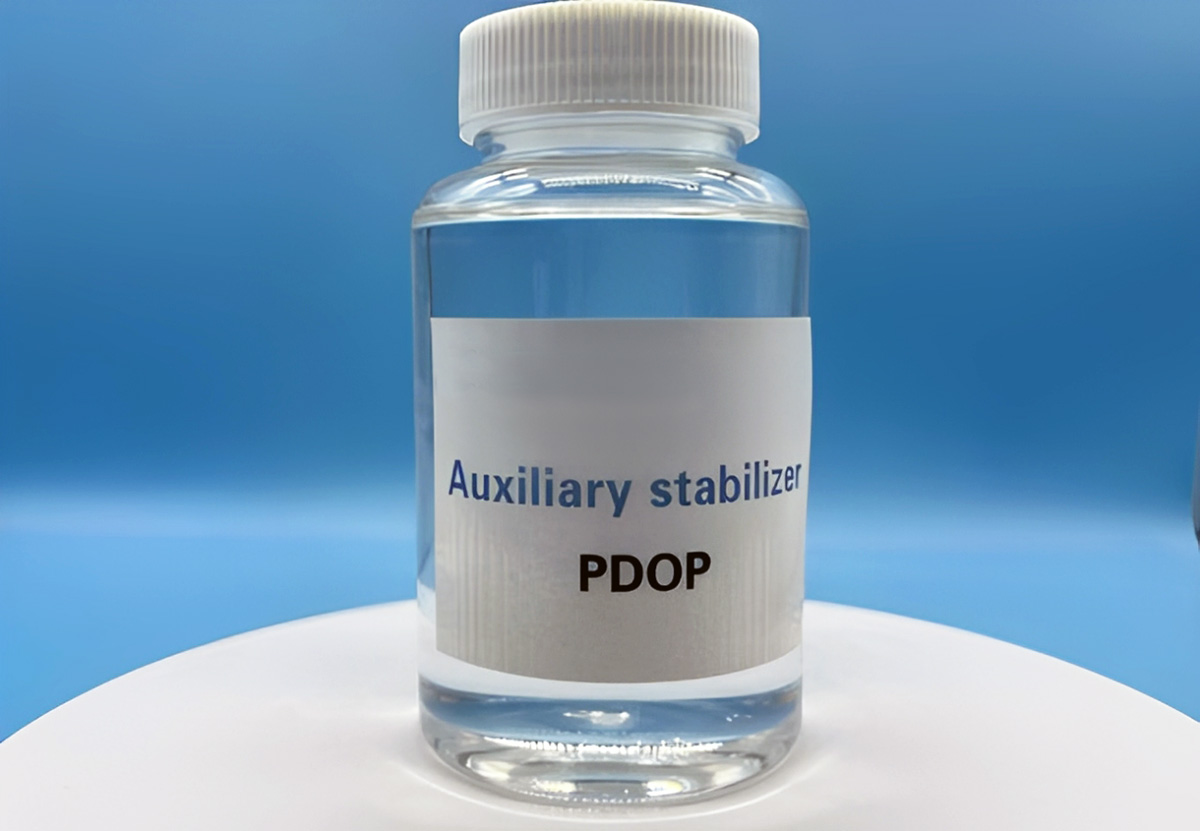
PDOP Phosphites Stabilizer
5.2 Epoxides
Epoxides are also indispensable auxiliary stabilizers in cadmium-free systems, having the effect of improving thermal stability, weather resistance, and transparency. The auxiliary stabilizing effect of epoxides depends on the stabilizer system. Generally, it has the greatest impact on calcium/zinc and barium/zinc stability, and has a certain effect on cadmium/barium and lead salts, but has no improvement in the stability of organotin. The liquid epoxides also function as plasticizers and lubricants, so in the soft PVC formulations that use epoxides, the amount of the main plasticizer is able to be reduced to a certain extent. Epoxides can also improve the light stability of barium/zinc and calcium/zinc systems. Additionally, epoxidized oleic acid esters have a low viscosity, which gives good low-temperature flexibility, and the volatility of epoxide is low, which can improve the extraction resistance.
The hydrogen chloride reaction of epoxides generates chloroethanol. Under the catalysis of metal soaps such as calcium and zinc, it replaces the unstable chlorine atoms in PVC and plays a stabilizing role. In static experiments, the effect of epoxides is to inhibit the yellowing of PVC. Using epoxides alone is not effective; when epoxides are used in combination with phosphoric acid, their effect can be significantly improved.
5.3 Polyols
Polyols can chelate metal ions, prevent the degradation catalyzed by chlorides, and can replace allyl chloride, thereby stabilizing PVC. Generally, the polyols used are soluble in water.
6. Chelating Agents
Chelating agents are almost all alkyl or aryl esters of phosphorous acid, which form complex compounds with metal salts. Their specific properties are as follows:
- Prevent the catalytic degradation of polyvinyl chloride resin.
- Minimize discoloration to the minimum extent.
- Prevent blooming.
- Improve the transparency of products.
- As they are themselves reducing agents, they can also act as antioxidants. However, they have poor heat resistance.
- The use of chelating agents can reduce the amount of main stabilizers.
- They cannot be used alone and must be used in combination with main stabilizers. The general dosage is 0.1% – 0.5% (by mass).
Among chelating agents, the most commonly used one is triphenyl phosphite (C₆H₅O)₃P, which is a colorless or slightly yellow transparent oil and insoluble in water.
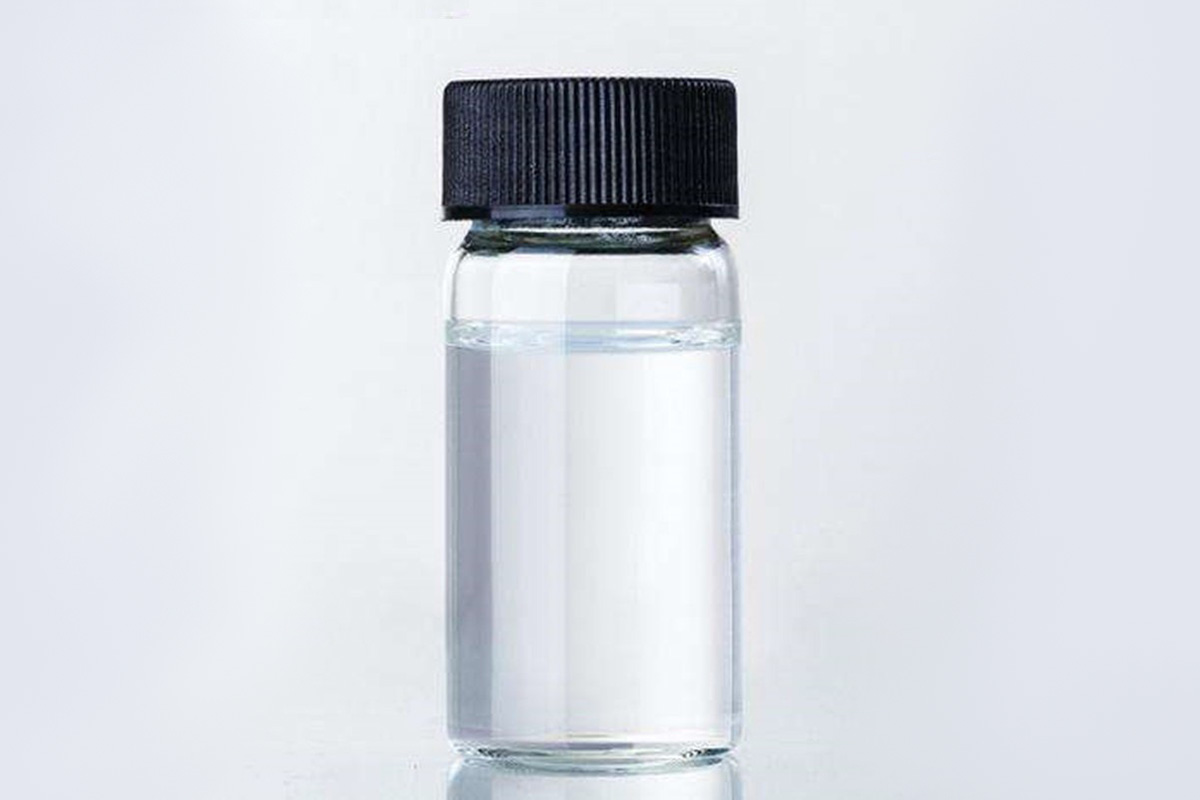
Chelating Agents of PVC – Triphenyl Phosphite
7. Main Stabilizer Classification List
| Category | Name | Abbr. | Properties |
|---|---|---|---|
| Basic Lead Salts | Triabsic Lead Sulfate | TS | Trisalts have excellent heat resistance and electrical insulation, and decent light stability. They are particularly suitable for high-temperature molding formulations. Trisalts are not lubricating and must be used in combination with lubricants and metal soaps. When used with lead stearate, the ratio of TS/PbSt should not exceed 1/4, otherwise, blooming will occur. Trisalts have a protective effect against ultraviolet rays. |
| Dibasic Lead Sulfite | DBL | The di-salt has outstanding weather resistance, with the ability to resist oxidation and shield ultraviolet rays. It also has good thermal stability and insulation, as well as good cold resistance. When used in combination with tri-salt, there is a synergistic effect. The heat resistance of di-salt is not as good as that of tri-salt, but it is better for lead stearate. | |
| Composite Stabilizers | Cadmium-Barium -Zinc Stabilizers | Cd-Ba-Zn | The composite stabilizer has good mixing and dispersion properties with resins and plasticizers, good transparency, usually used within low dosage, and is not prone to blooming. It can avoid dust poisoning and is the most widely used stabilizer. Among them: Cd-Ba-Zn: It has good light stability, heat stability and transparency, and thus one of the best transparent stabilizers nowadays. But it causes sulfurization pollution, has poor low precipitation performance, and is toxic. Ca-Zn: has good light stability, heat stability and transparency. It has poor blooming resistance and is non-toxic. Ba-Zn: has good light stability, heat stability and transparency. It has low blooming property and is low toxic. It’s also lubricating. |
| Cadmium--Zinc Stabilizers | Ca-Zn | ||
| Barium -Zinc Stabilizers | Ba-Zn | ||
| Metal Soap Salt Stabilizers | Lead Stearate | Pb-St | It has excellent lubrication properties and good light & heat stability. However, it is toxic and prone to causing sulfurization contamination. Therefore, it cannot be used in transparent products. |
| Cadmium Stearate | Cd-St | When used in combination with lead-based or barium-based soap salts as a stabilizer for PVC, cadmium soap has a wide range of effects. It has particularly significant effects in terms of transparency and improvement of weather resistance. When used alone, it lacks heat stability. During heat processing, it causes a rapid darkening phenomenon in the PVC compound. When used in combination with Ba soap and because their possess synergistic effect, they show excellent stability performance. | |
| Barium Stearate | Ba-St | It has excellent heat resistance, but when used alone, it will cause the product to turn red. Therefore, it should be used in combination with other stabilizers, especially with cadmium soap. When used in combination with Cd-based and Zn-based stabilizers, not only does the red color disappear, but the heat resistance of the Cd-based and Zn-based stabilizers is also significantly enhanced. | |
| Zinc Stearate | Zn-St | Non-toxic, with good weather resistance, but it has a significant catalytic accelerating effect on the degradation of PVC. The usage should be strictly controlled and it should not be used alone. | |
| Calcium Stearate | Ca--St | It’s non-toxic, won’t cause sulfurization pollution, excellent slip performance, excellent gelation. When used in combination with Cd-St, Pb-St, and Zn-St, there is a synergistic effect. Non-toxic when used in combination with Zn series. It can also be used in sulfurization-resistant combinations with organotin and Zn. | |
| Aluminium Stearate | Al-St | Non-toxic, suitable for dispersing color powders. | |
| Organotin | Maleate Tin | M-Tin | Like metal soaps, organotin can combine with hydrogen chloride, and interact with unstable chloride ions, and can also react with polyenes. Its thermal stability is very high. However, it can cause sulfurization pollution when combined with lead compounds, so they should not be used together. Organotin is mostly used alone and is one of the best transparent stabilizers. |
| Epoxy Series | Epoxidized soya bean oil | ESBO | When used in combination with Ca-Zn, it has an synergistic effect and is non-toxic. |
Conclusion
From highly transparent organotin stabilizers to cost-effective lead salts, and to non-toxic calcium-zinc complexes, each type of polyvinyl chloride heat stabilizer has unique advantages tailored to specific requirements, whether it is regarding heat resistance, electrical insulation, or safety compliance. This article covers the core characteristics and application tips of some major stabilizer categories, providing a foundation for your decision-making in polyvinyl chloride formulations. If you need to gain a deeper understanding of specific stabilizer types (such as complex metal soaps) or seek assistance in solving application problems, please feel free to contact our technical team at sales@kingstarmold.com. For more industry resources on polyvinyl chloride processing or other plastics, please continue to follow KingStar, the leading injection molding company in China.
Learn more about plasticizers in our related posts about plasticizers:
Properties of PVC Heat Stabilizers: A Comprehensive Guide
PVC Heat Stabilizers: Classification, Mechanisms & Key Insights for Formulation
